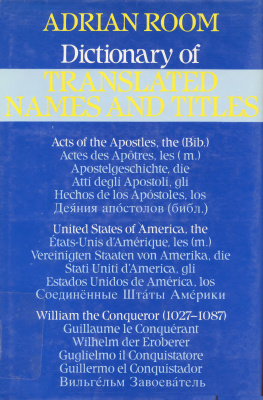Boston: Routledge Kegan & Paul, 1986 — 460 p. — ISBN10:
0-71009953-3 — ISBN13: 978-0710099532
(Словарь переведённых имен и названий на английском, французском,
немецком, итальянском, испанском и русском языках)
INTRODUCTION
The aim of this present dictionary is to supply not only the
traditional or agreed translations of over 4000 English names and
titles into five different foreign languages (French, German,
Italian, Spanish, Russian, as being the most common European
languages traditionally encountered by English speakers), but also
translations from each of these five languages into English. (The
latter is done by means of a separate cross-index section at the
end of the book; see page 295.)
Perhaps the really original contribution of the work is its large
number of translated titles (as distinct from mere geographical or
personal names). Here will be found a wide selection of the titles
of literary works (novels, plays, poems, and so on) as well as of
films and works of art (paintings, sculptures, architectural
monuments and the like). The literary works themselves range, via
the books of the Bible and other religious writings, from the
classics of Greek and Roman writers to mode fiction, and the
‘artistic’ titles embrace not only films and the fine and applied
arts but musical works (operas, ballets, symphonies, for example)
and more miscellaneous creations such as the Bayeux Tapestry
(really a name, more than a title) and Cleopatra’s Needle (more a
nickname).
For ease of reference, all true titles in the dictionary are
printed in italics, with the exception of the Russian titles which,
as is customary in that language, are given in quotes.
The names in the dictionary cover not only geographical and
personal names (places and people) but also historical events
(wars, battles, pacts, revolutions) and inteational organisations
such as the United Nations and the World Health Fund. Personal
names cover not only well-known historical characters, including
those known by nicknames (Eric the Red, Charles Martel), but also
biblical personages, mythological characters, saints, popes,
fictional characters (Man Friday) and semimythical persons such as
Robin Hood and King Arthur. There are also a good representation of
astronomical names, whether or not based on the characters of
classical mythology, as many of them are.
The entries are arranged under their English alphabetical order,
with the English (GB) name or title followed by its equivalents in
French (F), German (D), Italian (I), Spanish (E), and Russian (SU),
these abbreviations being, for convenience, those of the respective
countries’ Inteational Vehicle Registrations.
All titles are printed in italics except for the Russian, which are
in quotes. This means that all the other entries not in italics are
regarded as
names. Books of the Bible, however, are not italicised as titles.
names. Books of the Bible, however, are not italicised as titles.

